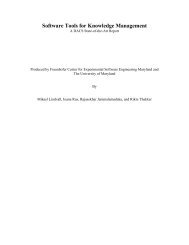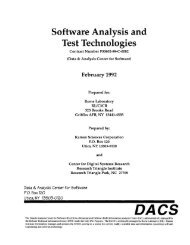Modern Empirical Cost and Schedule Estimation Tools
Modern Empirical Cost and Schedule Estimation Tools
Modern Empirical Cost and Schedule Estimation Tools
You also want an ePaper? Increase the reach of your titles
YUMPU automatically turns print PDFs into web optimized ePapers that Google loves.
Cocomo 1.1 models software projects as exhibiting decreasing returns to scale. Decreasing returns are<br />
reflected in the effort equation by an exponent for SLOC greater than unity. This exponent varies among<br />
the three Cocomo 1.1 development modes (organic, semidetached, <strong>and</strong> embedded). Cocomo 2.0 does not<br />
explicitly partition projects by development modes. Instead the power to which the size estimate is raised<br />
is determined by five scale factors:<br />
* Precedentedness (how novel the project is for the organization)<br />
* Development flexibility<br />
* Architecture/risk resolution<br />
* Team cohesion<br />
* Organization process maturity.<br />
Once an architecture has been established, the Cocomo 2.0 Post-Architecture model can be applied. Use<br />
of reengineered <strong>and</strong> automatically translated software is accounted for as in the Early Design equation<br />
(ASLOC, AT, ATPROD, <strong>and</strong> AAM). Breakage (BRAK), or the percentage of code thrown away due to<br />
requirements change is accounted for in 2.0. Reused software (RUF) is accounted for in the effort<br />
equation by adjusting the size by the adaptation adjustment multiplier (AAM). This multiplier is<br />
calculated from estimates of the percent of the design modified (DM), percent of the code modified (CM),<br />
integration effort modification (IM), software underst<strong>and</strong>ing (SU), <strong>and</strong> assessment <strong>and</strong> assimilation (AA).<br />
Seventeen effort multipliers are defined for the Post-Architecture model grouped into four categories:<br />
* Product factors<br />
* Platform factors<br />
* Personnel factors<br />
* Project factors.<br />
These four categories parallel the four categories of Cocomo 1.1 - product attributes, computer attributes,<br />
personnel attributes <strong>and</strong> project attributes, respectively. Many of the seventeen factors of 2.0 are similar to<br />
the fifteen factors of 1.1. The new factors introduced in 2.0 include required reusability, platform<br />
experience, language <strong>and</strong> tool experience, personnel continuity <strong>and</strong> turnover, <strong>and</strong> a factor for multi-site<br />
development. Computer turnaround time, the use of modern programming practices, virtual machine<br />
experience, <strong>and</strong> programming language experience, which were effort multipliers in Cocomo 1.1, are<br />
removed in Cocomo 2.0.<br />
A single development schedule estimate is defined for all three Cocomo 2.0 models, as shown in the<br />
second row of Table 2.<br />
<strong>Modern</strong> <strong>Empirical</strong> <strong>Cost</strong> <strong>and</strong> <strong>Schedule</strong> <strong>Estimation</strong> <strong>Tools</strong><br />
12




